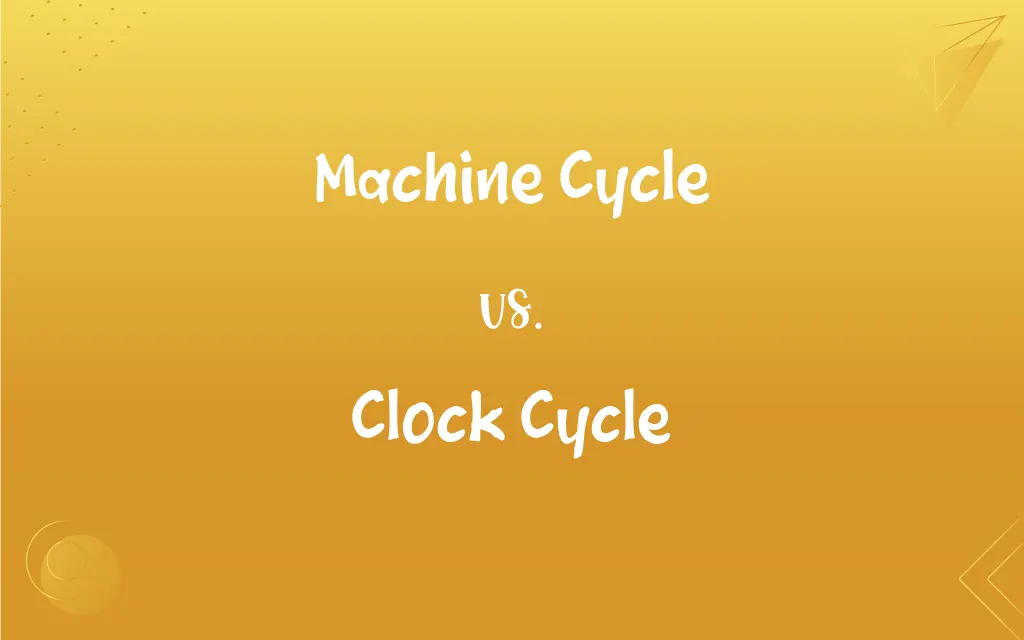Machine Cycle vs. Clock Cycle: What's the Difference?
Edited by Aimie Carlson || By Harlon Moss || Updated on October 9, 2023
Machine cycle encompasses steps a CPU takes to process data; clock cycle is the time taken for one oscillation of the CPU's clock.

Key Differences
A machine cycle refers to the series of steps that a central processing unit (CPU) performs to fetch, decode, and execute instructions. Each instruction can take multiple machine cycles, depending on the complexity of the instruction. Conversely, a clock cycle is a single oscillation of the computer's clock, determining the speed at which a CPU can process instructions.
The duration of a machine cycle is largely dependent on the number of clock cycles it requires to complete. While one machine cycle can encompass multiple clock cycles, a clock cycle is a fixed and consistent measure of time. This time period is set by the frequency of the computer's clock.
With advancements in technology, CPUs have been designed to process certain instructions in a single machine cycle. However, the relationship between a machine cycle and clock cycle remains: a machine cycle will always consist of one or more clock cycles. The clock cycle essentially dictates the pace at which machine cycles can proceed.
In terms of measuring performance, the clock cycle provides a more consistent metric, as it remains stable. Machine cycles can vary in duration due to the varying nature of the instructions being processed. Thus, while both the machine cycle and clock cycle pertain to the operation of the CPU, they offer different perspectives on processing speed and efficiency.
Comparison Chart
Definition
Steps CPU takes to process an instruction
Time for one oscillation of CPU's clock
ADVERTISEMENT
Duration
Varies based on instruction
Consistent and set by clock frequency
Units of Time
Comprised of multiple clock cycles
Single, fixed unit of time
Performance Metric
Can vary in length
Stable and consistent measure
Relation to CPU Operation
Describes stages of instruction processing
Dictates the pace of processing
Machine Cycle and Clock Cycle Definitions
Machine Cycle
A measure of how quickly a CPU can execute specific instructions.
Reducing the machine cycle time can lead to faster program execution.
ADVERTISEMENT
Clock Cycle
A metric used to measure the speed of computer processors.
A shorter clock cycle duration often translates to a faster CPU.
Machine Cycle
A unit of operation in which an instruction is fetched, decoded, and executed.
The machine cycle of older CPUs was often longer than that of contemporary ones.
Clock Cycle
Time duration for a single oscillation of the computer's clock.
A faster clock cycle means quicker CPU operations.
Machine Cycle
Sequence of steps a CPU undergoes to process an instruction.
Modern CPUs aim to reduce the machine cycle count for efficiency.
Clock Cycle
The basic unit of time that dictates CPU operations.
The clock cycle determines how fast data is processed.
Machine Cycle
The complete operation of processing an instruction, including memory access.
The addition of cache memory can speed up the machine cycle.
Clock Cycle
A rhythm or pulse that sets the pace for CPU tasks.
The CPU waits for the next clock cycle to proceed with operations.
Machine Cycle
The stages of operation including fetch, decode, execute, and sometimes store.
During the machine cycle, the CPU coordinates with other components to process instructions.
Clock Cycle
The period between two adjacent pulses of the CPU's oscillator.
With each clock cycle, a new operation can commence.
FAQs
How is a clock cycle related to a CPU's speed?
A clock cycle determines the rate at which a CPU processes instructions.
Does a faster clock cycle always mean better performance?
Generally, a faster clock cycle improves performance, but other factors like architecture also play a role.
How can one reduce the number of machine cycles for an operation?
CPU optimizations and architectural improvements can reduce machine cycles for specific tasks.
Is the clock cycle duration constant in a CPU?
Typically, a CPU's clock cycle duration remains consistent, though dynamic frequency scaling can adjust it.
Are all machine cycles of equal duration?
No, machine cycle duration can vary based on the instruction being processed.
How has the relationship between machine cycle and clock cycle evolved over time?
Technological advancements have allowed some instructions to be processed in fewer machine cycles, often just one.
What is a machine cycle in computing?
A machine cycle encompasses the steps a CPU takes to process an instruction.
What dictates the length of a clock cycle?
The computer's clock frequency sets the clock cycle's length.
Why do modern CPUs focus on reducing machine cycle durations?
Shorter machine cycles lead to quicker instruction processing, enhancing overall CPU performance.
Can a single instruction require multiple machine cycles?
Yes, depending on the instruction's complexity and the CPU's design.
Can a machine cycle be shorter than a clock cycle?
No, a machine cycle will always encompass one or more clock cycles.
Why is clock cycle an important metric in computing?
Clock cycle provides a consistent measure of CPU speed and performance.
What are the stages of a typical machine cycle?
Common stages include fetch, decode, execute, and sometimes store.
Does a shorter clock cycle result in more power consumption?
Often, a shorter clock cycle or higher frequency can lead to increased power consumption.
How do cache and memory access affect the machine cycle?
Efficient cache use can reduce memory access times, speeding up the machine cycle.
Is the machine cycle a good metric for CPU performance?
While informative, it's just one aspect. Overall performance considers both machine cycle and clock cycle, among other factors.
How do machine cycles and clock cycles relate?
A machine cycle consists of one or more clock cycles, depending on instruction processing.
Which has a more variable duration, machine cycle or clock cycle?
Machine cycle durations are more variable as they depend on the instruction processed.
What happens during one clock cycle in a CPU?
During one clock cycle, the CPU can perform a basic operation or part of a more complex operation.
Can clock cycle vary in dynamic systems?
Yes, with dynamic frequency scaling, clock cycles can adjust based on system demands.
About Author
Written by
Harlon MossHarlon is a seasoned quality moderator and accomplished content writer for Difference Wiki. An alumnus of the prestigious University of California, he earned his degree in Computer Science. Leveraging his academic background, Harlon brings a meticulous and informed perspective to his work, ensuring content accuracy and excellence.
Edited by
Aimie CarlsonAimie Carlson, holding a master's degree in English literature, is a fervent English language enthusiast. She lends her writing talents to Difference Wiki, a prominent website that specializes in comparisons, offering readers insightful analyses that both captivate and inform.































































